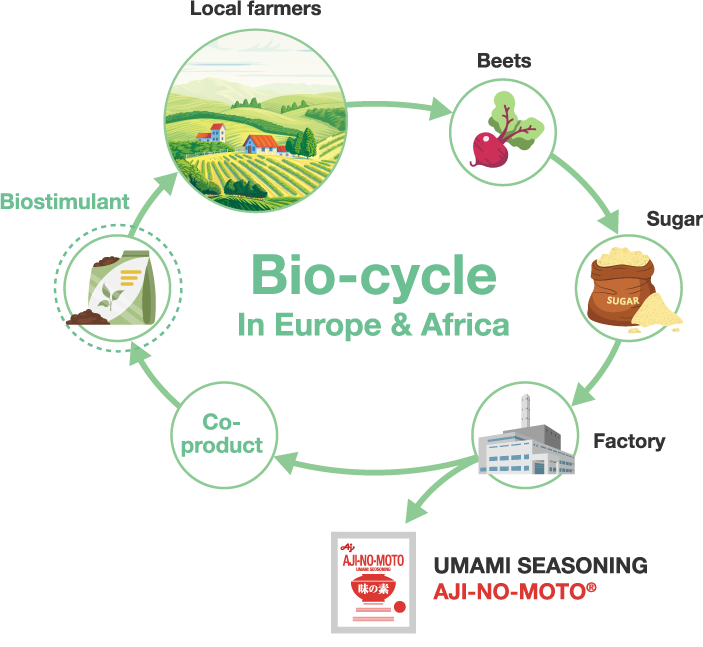In these everyday situations, discover how amino acids help you live better!
Which of the topics interest you the most?

#1 The Taste of Food
I want more
YUMMY foods!
Amino acids hold the key to tastiness!
Did you know amino acids play an important role in the taste of food?
There are 20 kinds of amino acids that make up proteins and all of them can be classified into amino acid families according to their taste: sweetness, bitterness or umami. The combination and ratio of these amino acids contained in food is one of the important factors for the taste in food.
Five basic tastes
Do you know how many flavors exist in the world? It has long been said that there are 4 basic tastes namely sweet, sour, bitter, salty. However, it has been advocated by Japanese researchers that umami, discovered by Dr. Ikeda Kikunae, is also one of the basic tastes. In 2002, receptors that actually sense umami were identified, and it was proved scientifically that umami is one of the basic tastes. Today, the taste of food is thought to be made up of a combination of these five basic tastes.

Roles of basic tastes
The basic tastes play an important role in providing nutrients to the body.

To ensure adequate
intake of carbohydrates
for energy in the body.

To prevent intake of
toxic substances into
the body. Also helps
detect ripeness.

To ensure adequate
intake of salt to regulate
the amount of water
in the body.

To prevent intake of
poisonous substances
into the body.

To ensure adequate
intake of proteins for
proper growth and
maintenance of the body.
We depend on the basic tastes for choosing and ingesting the necessary nutrients for our well-being.
Fermented foods are rich in amino acids
Fermented foods are one of the ways that we have learned to make food more delicious. Why does food become more delicious?
Because when we ferment foods such as soy, fish and milk, the proteins are digested and become amino acids, which produce various tastes. For example, during fermentation, protein in milk is decomposed into free amino acids that create the taste of cheese!


Each amino acid has a different taste which is an important function
to make up the taste of cheese.
The longer the fermentation, the greater the variety of amino acids and the fuller the taste.

#2 Good Health
Everyday health starts
from the inside!
Amino acids and Nutrition
Nutrients are the substances found in food that drive biological activity and are essential for the human body. Amino acids are the building blocks of proteins, one of the five essential nutrients.

There are 20 amino acids in our human body


9 amino acids that are known as “essential amino acids” must be taken from food.
Essential amino acids
- •Leucine
- •Isoleucine
- •Methionine
- •Valine
- •Histidine
- •Threonine
- •Phenylalanine
- •Lysine
- •Tryptophan
The remaining 11 of amino acids known as “non-essential amino acids” can be synthesized from other amino acids in the body.
Non-essential amino acids
- •Aspartic acid
- •Cysteine
- •Proline
- •Alanine
- •Asparagine
- •Arginine
- •Glycine
- •Glutamine
- •Glutamic acid
- •Serine
- •Tyrosine
Amino acids are not only used to form muscles, bones, skin, and other internal organs, they are also used to produce hormones and enzymes that maintain and regulate body processes, antibodies that protect against illness and neurotransmitters.

Amino acids for a healthy life

For Sarcopenia (Progressive loss of muscle)
As we reach old age, our muscle mass and strength naturally declines, and we grow weaker. This natural condition is called Sarcopenia and it affects everyone. To prevent and treat Sarcopenia, the right exercise and consumption of sufficient proteins is necessary. Recent studies have found a clear link between the consumption of amino acids, Leucine in particular, and exercise, with the increase of muscle mass and muscle strength.

For Good quality sleep
Getting good quality sleep means that you sleep deeply and soundly when you go to bed.
The latest research shows that taking glycine which is one of amino acids before bed helps you to quickly and naturally fall into a deep sleep. By supplementing your diet with the appropriate amino acids, you will probably benefit from a better quality sleep that will help you to rest your mind and body!

For Hangovers
The hangover saver is here! When we drink too much alcohol, we may well get a hangover, from the acetaldehyde that is produced from alcohol. Taking the amino acids alanine and glutamine before and after drinking and the following day has proved to promote the liver function and reduce hangovers!
Of course, we should always consume alcohol responsibly!

#3 Stay Beautiful
Stay Healthy and
Stay Beautiful !
Amino Acids – Natural Moisturizing Factor for Skin
The outermost layer of the skin has a natural moisturizing factor (NMF) that helps maintain moisture in the skin. When the amount of NMF drops, the amount of water in the skin also diminishes and causes it to become dry and coarse. In addition, the amount of collagen decreases with ageing and exposure to UV rays. This is another component known for keeping the skin supple. The main components of both NMF and collagen are amino acids. In other words, using amino acids helps keep your skin look beautiful and healthy!


Amino Acids for Damaged Hair Cuticles
Moisture retention is just as important for hair as it is for skin.
The cuticle is the outermost part of the hair and plays an important role in retaining moisture and the amino acids in cuticles work to retain it. Using shampoos, conditioners and treatments that contain certain amino acids helps promote moisture retention and prevents hair from breaking. Amino acid care helps give you smooth and silky hair!

Amino Acids are Environmentally Friendly
Soaps and detergents are flushed away with household wastewater. Ideally, they should be biodegradable, so they can rapidly decompose in the environment. Even if these products are released into rivers and lakes, they can be broken down by microorganisms into carbon dioxide and water. Since amino acids are building blocks of living things, they are readily broken down in natural environments. Many popular detergents nowadays are made by combining amino acids such as glutamate and glycine with fatty acids.
Try to use beauty products containing amino acids to preserve your own beauty and that of the planet!

#4 High Performance
Be active and enhance
your sports performance!
Ideal nutrients for sport
Amino acids are ideal nutrients for sport. Why? The answer is very simple. Proteins are the main component of muscle and proteins are made of amino acids. Amino acids can be absorbed by the body in just 30 minutes, and it is much faster than absorbing proteins because proteins eventually have to be digested into peptides and amino acids before they can be absorbed.
BCAAs to improve your performance
Approximately 40% of the essential amino acids that make up muscle are BCAAs (branched-chain amino acids) that consist of valine, leucine and isoleucine. Supplementing before or during exercise with BCAAs, gives the body energy to move and reduces muscle breakdown and damage. Supplementing with BCAAs right after exercising or before bed helps damaged muscles recover faster and reduces damage such as muscle soreness!
Exerc Metab. 20(3): 236-244.(2010)


#5 Enhancing Well-being
Learn more about
your life saver!
Amino acids are essential to Medicine
Amino acids were used in medicine for the first time in 1956 and Japan was the first country in the world to make a medical infusion containing high-quality amino acids.
The infusions contain the five major nutritional elements needed to sustain life: proteins, sugars, fats, vitamins and minerals. Since the body rejects proteins causing side effects such as nausea and fever, infusions containing a mixture of amino acids instead of proteins became a way of providing nutrition to patients and used before and after surgery as an essential treatment for patients who cannot eat or drink. They are widely used today for this reason.

Amino acids alone have various effects.
Glutamine has been noted for its ability to repair the mucous membranes of the digestive tract and is used as a treatment for ulcers.
Arginine is known for immune-enhancing effects and helps not only healthy people, but also patients after operations with impaired immune functions, patients undergoing intensive care, and patients infected with the HIV virus.
Amino acids are used as pharmaceutical intermediates in many medicines all over the world such as antibiotics, antihypertensives, hypoglycemic agents, and antiviral medicines.

#6 Sustainable Planet
Our health depends on
the health of the planet
Environmentally friendly “Bio-cycle”
The Ajinomoto Group produces amino acids through fermentation processes from crops that are easily available in each region. We use the nutritionally rich co-products (by-products) that remain after extracting amino acids in the fermentation process, as fertilizers and sell them to local farmers. Then, the farmers use the fertilizers on their plants and these plants become raw materials of amino acids! This is what we call “bio-cycle”.

Amino acids based biostimulant
Ajinomoto, also, uses these co-products to produce biostimulants.
What is a “Biostimulant”? A biostimulant is any substance or microorganism applied to plants with the aim to enhance nutrition efficiency, abiotic stress tolerance and/or crop quality traits. Ajinomoto mainly uses raw materials of plant origin, and formulates them using its own technological process, creating natural products that help crops to be more resistant to external agents and increase the fertilizer’s efficiency, reducing the use of agrochemicals.
Farmers using Ajinomoto biostimulant will therefore enjoy higher yields and better-quality produce.
Biostimulant has demonstrated in many studies that it has a positive impact on environment.
For example







The Environmentalism of AJI-NO-MOTO®



